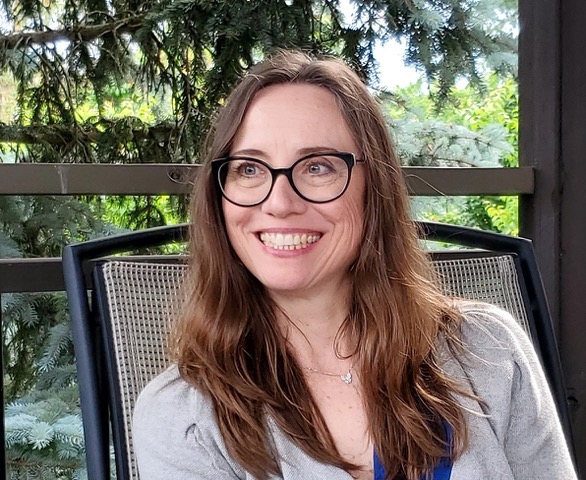By Tracey Ciccone Edelist
It took some imagination to see my dad in me. We look nothing alike, so I had to go beyond the obvious to find similarities: crooked teeth, hidden skin tags and blemishes, a propensity to worry, maybe cheekbones and chins—he hides his under a beard so it’s hard to say. I share more physical similarities with my blue-eyed, blonde-haired stepmother who has been my mom since my birth mother left one day when I was barely a toddler. We used to look at each other and smile conspiratorially when strangers commented on how much I looked like Mom.
I worked hard to see those bits of Dad in me, so when my eldest child did a consumer DNA test “for fun” and uncovered my birth mother’s secret about my paternity, I didn’t know who I was looking at in the mirror anymore. Within a few hours, we’d found photos online of women, sisters of the suspected DNA father, who looked like me and my children. Then I found a black and white photo of him from 1975. I would have been four. It’s a close-up shot. He’s sitting in the driver’s seat of a car wearing a wide-lapelled winter coat and ‘70s patterned scarf, smiling for the camera, his arm resting on the open window. I saw my eyes, my forehead, my face shape, my lips, my skin tone. That photo, and those of his sisters, my aunts, made it hard to deny what the DNA test had revealed.
The first time I caught my reflection in the mirror after looking at their photos, I jumped, and then I stared, unbelieving. I saw him and his sisters looking back at me, their features superimposed on my own. I had spent so long convincing myself my cheekbones came from my dad, so many years establishing that untrue story of who I was, and now, there were these unknown people who looked like me, presenting themselves uninvited in my face, pushing Dad away from it. For months, every time I saw myself in the mirror, and every time I looked at my young adult children, I felt an electric shock of disbelief zap through me, wrenching me into a surreal world that didn’t make any sense. I no longer knew who we were, who I was, except that I was now half Italian.
It took quite some time for my brain to adjust, for my synapses to rewire to incorporate this new information, to rebuild my identity from scratch. I began to write to help me process everything, to get the intrusive, persistent thoughts out of my brain and onto the page. The story below is a short piece of creative non-fiction that represents an unsettling that follows these DNA discoveries. The woman seeks refuge in nature. It grounds her, but the turmoil underneath remains and breaks through.
The Sky in the Lake
A woman stands on the dock like a genie captured inside a photograph. Only the call of the blue jay and the rustling of chipmunks digging through leaves on the shore indicate freedom of movement. Across the glassy water, the sky is split in half by a swathe of trees. They grow in symmetry both upward and downward, a thin horizontal line marking the middle point, or is it the starting point? Right-side-up and upside-down trees. Beside her, to the left, a heron stands at the water’s edge admiring his beauty in the mirror.
There’s a square wooden raft in the middle of the sky below the upside-down trees. It hovers like a magic carpet stalled on the clouds. She stares at the raft in the sky in the lake and wonders what it would be like to float, sitting on a cloud.
She knows the sky in the lake is an illusion of nature. Sunlight reflects off the trees and clouds, striking the water’s still surface, projecting an image. Unseen underneath, turtles weave amongst aquatic plants, fish dart through underwater forests, weeds sway like a mermaid’s long, green hair in the current flowing from the rapids upstream. Sometimes creatures break through the surface, dispersing rings of ripples or zig zags of flutters across the water, but not now. Now, the lake appears still, and the sky appears in the lake.
The woman appears still too. She inhales deeply, breathing the lake’s bright beauty into her being. Clean, earthy air enters her nostrils and fills her lungs with a wish to still her thoughts and calm her body.
Her friends tell her she’s “still the same person,” but she is not. She wonders who they think of when they think of her, because she’s never been “still the same.” Even in stillness synapses fire at lightning speed. A scan of her brain would illuminate the screen with persistent pulsating lights. Reds, oranges, yellows—favorite colours of fall—painting her brain. These warm colors of activity are the same colors the leaves will turn before they drop to the ground and decay.
You may not notice that she is harried in her stillness. The scene of the lake soothes, yet if you touch her arm you might feel it—the incessant electric thrum readying her for fight or flight. Even when she sleeps, she is not still. Turning, thrashing, too hot, too cold, talking, whimpering, twisting in sheets, waking up in a sweat, wondering where she is and who she has become.
She looks down and is startled by her own reflection. Her mournful cry sends birds flapping out of trees and chipmunks scampering up rocks, while the sky in the lake begins to quiver.

Tracey Ciccone Edelist has a PhD in social justice education and is a critical disability studies researcher and educator. She had a previous career as a speech-language pathologist, then as a fine chocolate entrepreneur. Now, she’s making sense of life through creative nonfiction. You can find her at her Substack, Write Out of Hiding.

